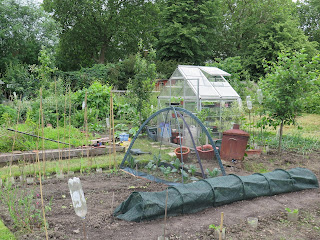 |
| A strange reflection |
Back at National Gallery as we travel through time and space - this time we started with the Diego Spanish artist Velazquez and his famous painting
'The Toilet of Venus' aka "The Rokeby Venus".
Velazquez whose artistry was championed by Rubens long campaigned for his king to grant him a Knighthood and as a painter of the Spanish King he was eventually granted the title a matter of a couple of years before his death in 1660
The actual painting shows an elegant nude but the reflection in a mirror (if that's what it is) held by Cupid has caused much controversy.
This is the only remaining Nude in existence from Velasquez and shows a strong classical sculptural influences, the artist is strongly associated with the Baroque but it is quite possible to question if this particular painting is a truly Baroque work as it lacks something of the excessively sumptuous.
 |
| Is it Immaculate? |
An example of his more Baroque work is shown (right) The Immaculate Conception with Stars around Mary's head.
The paintings of his King clearly reflect the closeness between ruler and subject - the later work being painted when Velasquez was about 50.
 |
| Spanish King Philip IV 1631-2 as a young man |
 |
| And sometime older and later (1656) |
One of the paintings by Velasquez - a favourite of mine that we didn't look at (
and one I'd observed before) this is of a less formal style was
Christ in the House of Martha and Mary - it's from a bible story and this uses a quite unusual perspective showing action in two rooms.
 |
| All happening in the kitchen |
Away from the Baroque it was interesting to see the contrast with luscious works and the everyday portrayed by
Francisco de Zurbaran (who worked as an official in Art for the Church) in
A cup of Water and a Rose - 1630 - this is a apparently a very popular work to purchase in the gallery shop as a postcard.
There is a school of thought that although appearing initially simple the work contains much symbolism.
Another interesting artist and a work by him the self portrait of
Bartolome Esteban Murillo (below) who sadly died following a fall from scaffolding as he worked on a commission.
The work shows much in the way of artistry (the frame within the work) as well as the tools of his trade.
The last artist under the spotlight was
Michelangelo Merisi da Caravaggio and his work really stood out against the formulaic work of his time - the main picture we looked at was
'The Supper at Emmaus' which showed Jesus and others as 'normal' mortals.
 |
| 'The Supper at Emmaus' by Caravaggio |
Many of the artistic establishment of the time questioned the value of such works as it went against the accepted styles.
All 3 of the National's Caravaggio's were on show.
The Caravaggio paintings seem to signal a new approach to Art and Religion moving to representations that more accurately mirror the experience of the population at large with a style that is less elitist and 'truer' - be great to see where our journey takes us next week.
Red 135
Another red object that popped out of the sky
 |
| Look up! A surprising discovery in a tree by City Hall |






















































